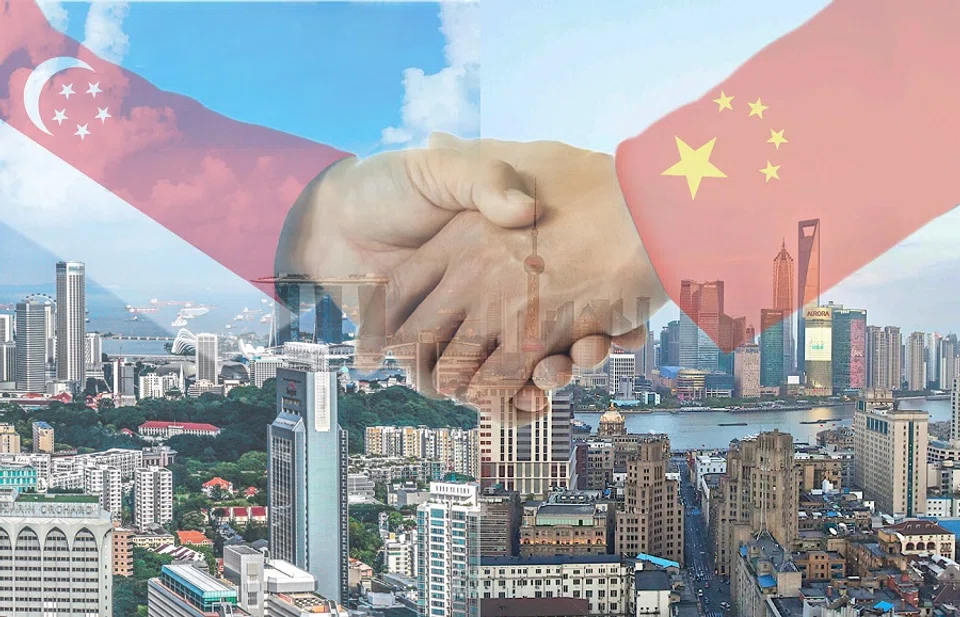Chinese ambassador Hong Xiaoyong: New journey for China's development; new opportunities for China-Singapore cooperation
China's next phase of development will focus on achieving high-quality development and building a modern socialist country, says China's ambassador to Singapore, Hong Xiaoyong. Much attention will be paid to fostering innovation and green growth, and in pursuing a coordinated approach in building prosperity for the Chinese people. China will also continue to engage the world through its dual circulation strategy, turning the China market into a market accessible to all. In these efforts, there are many opportunities for Singapore and China to work together, building on their years of cooperation and synergies. Ambassador Hong wrote this article in commemoration of the 30th anniversary of the establishment of diplomatic relations between China and Singapore.

The recently concluded Fifth Plenum of the 19th Central Committee of the Communist Party of China (CPC) attracted much global attention. The proposals raised for formulating the 14th Five-Year Plan (2021-2025) for economic and social development and the long-range goals for 2035 will not only directly affect China's future, but also global development.
Formulating and implementing mid- and long-term plans are important ways by which the CPC governs the country and leads economic and social development. The 14th Five-Year Plan builds on the success of the 13th Five-Year Plan. During the course of the 13th Five-Year Plan, China's economic, technological, and comprehensive national strength leapt to new heights. Between 2016 and 2019, China achieved an average annual economic growth rate of 6.7%. It is expected that China's GDP will exceed 100 trillion RMB in 2020. Additionally, 55.75 million rural residents have been lifted out of poverty, 1.3 billion Chinese are covered by basic medical insurance while nearly one billion enjoy basic pension insurance. The ecological environment across the country has also improved significantly. The first centennial goal of achieving a moderately prosperous society in all aspects is about to be realised, and the country will soon embark on a new journey of building a modern socialist country in all aspects.

The adoption of proposals that considers the 14th Five-Year Plan in conjunction with long-range goals for 2035 is a first in setting China's mid- to long-term plans. In the face of new and higher goals, the coordinated and consolidated planning of China's short-, mid-, and long-term developmental goals strongly reflects the country's push for "high-quality development" and its progress towards a new development paradigm.
On the path of green growth
High-quality development refers to the ability to cater to people's growing needs for a better life. It involves a new development mindset that is driven first and foremost by innovation, that internalises coordination, and that regards going green as the norm, openness as the road one must take, and sharing as a fundamental goal.
Innovation will be placed at the core of modernisation and be the primary driving force for high-quality development.
It was said during the 19th National Congress of the CPC in 2017 that China's economy has transitioned from "a phase of rapid growth to a stage of high-quality development". Over the past three years, under the guidance of this policy, China has made significant changes in its development mode and focus. It no longer sees GDP growth as the main criterion for its development evaluation. Rather, it promotes social cohesion and sustainable development according to the five-sphere integrated plan which established a social development consensus that "green is gold" (绿水青山就是金山银山, clear water and green mountains are "gold mines"). Pressing on with a high-quality development model is not only necessary to enable China's economy to adapt to new trends and upgrade itself, but also to meet the people's demands for a higher standard of living.

To achieve high-quality development, China is set to transform its development approach by deepening supply-side structural reforms. Innovation will be placed at the core of modernisation and be the primary driving force for high-quality development. China will hence establish a new mechanism for coordinated regional development, improve its systems and mechanisms for integrated urban-rural development, and promote coordinated development. It will also implement in-depth sustainable development strategies and promote green growth. In addition, China will bring about wider, broader and deeper opening up and enhance international cooperation. It will also firmly work towards common prosperity, so that there can be an even more equitable distribution of the fruits of reform and development.
China's new development paradigm is a strategic decision made based on changes in the domestic and international situation. It is an active decision and not a passive response; it is also a long-term strategy and not a stop-gap measure.
Domestic and international circulation complement each other
In May this year, Chinese President Xi Jinping proposed a new development paradigm with domestic circulation as the mainstay and domestic and international circulations reinforcing each other. This has received attention in Singapore. Deputy Prime Minister Heng Swee Keat said at the FutureChina Global Forum 2020 that "Southeast Asia will be an increasingly important part of China's 'international circulation'". Former Foreign Minister George Yeo expressed in his articles in ThinkChina and Lianhe Zaobao that "Singapore will play an essential role in China's external circulation economy".
China's new development paradigm is a strategic decision made based on changes in the domestic and international situation. It is an active decision and not a passive response; it is also a long-term strategy and not a stop-gap measure. Internationally speaking, deglobalisation has gained momentum, unilateralism and protectionism are on the rise, the Covid-19 pandemic has brought about far-reaching impacts, and traditional international economic circulation has significantly weakened or even been blocked. Domestically speaking, China's economic rebalancing efforts have achieved great strides in recent years, and economic growth has become increasingly dependent on domestic consumption and investment. Strengthening the position of domestic circulation as the mainstay will make China's economic development more resilient.

The aim of the new development paradigm is to grow domestic demand and boost economic circulation. But this does not mean closed-door domestic circulation, but an open-door dual circulation system where domestic and international circulation stimulate and complement each other, for better connections between domestic and international markets. As President Xi Jinping said recently at the third China International Import Expo (CIIE), China will steadfastly expand all-round opening-up and explore more efficient ways to connect domestic and foreign markets and share factors of production and resources. The aim is to turn the China market into a market for the world, a market shared by all, and a market accessible to all.
However the international situation changes, China's basic policy of staying open will not be shaken. China will continue to leverage the leading role of pilot free trade zones and free trade ports, promote the establishment of a new pattern for open economies at a higher level, and support companies from all over the world to open up business opportunities in China. Recently, the third CIIE was held both online and offline as scheduled, while the Belt and Road Initiative (BRI) has become the most globally prominent international public good, and is playing an increasingly important role in strengthening economic integration between cooperative partners while moving into a phase of high-quality joint construction.
China's development is a relay race fuelled by the perseverance to see one blueprint through a step at a time, and to build on old and current successes while continuing to innovate according to circumstances. China's development needs to be in line with domestic and external changes, and it will not stop, but will continue to bring market opportunities, as well as opportunities for investment and growth to the world.
China looks forward to deepening cooperation in public health, the digital economy, green growth, the legal and judicial system, and diverse investment, while exploring more areas and methods of third-party cooperation [with Singapore].


China and Singapore can work together
This year, we celebrate the 30th anniversary of China-Singapore diplomatic relations. These 30 years of cooperation have been marked by both sides moving with the times and aligning with each other's development strategies. The Suzhou Industrial Park, Tianjin Eco-City, China-Singapore (Chongqing) Demonstration Initiative on Strategic Connectivity, and the Guangzhou Knowledge City have reaped good socioeconomic benefits and driven innovation in cooperative models and ideas. Given the tough task of post-pandemic economic recovery and growth, and complex changes in the external environment, China and Singapore have both set a course of high-quality development, and continue to actively push for globalisation and to maintain a favourable environment for an interconnected world. At this crucial juncture, there is a greater need for a close alignment of development strategies between China and Singapore, and to work together for the future. China's high-quality development and new development paradigm will provide important opportunities for this.
The dual circulation system with domestic and international reinforcing each other will give support to connectivity between China and Singapore and within the region following the pandemic. Building on connectivity, financial support, and third-party cooperation in the BRI, China looks forward to deepening cooperation in public health, the digital economy, green growth, the legal and judicial system, and diverse investment, while exploring more areas and methods of third-party cooperation. The New International Land-Sea Trade Corridor is a regional connectivity backbone built by China and Singapore, which has grown rapidly and shown excellent results in recent years, especially during the pandemic. The Trade Corridor and Lancang-Mekong Cooperation will complement each other in promoting the construction of a more innovative, secure, and reliable industrial supply chain in this region.

China's high-quality development and new development paradigm will be implemented at the local and grassroots level, and sub-national cooperation between China and Singapore will play a more important role in future alignment of the development strategies of both countries. Singapore has already established cooperation frameworks with eight provinces and cities in China, and this year's pandemic has not dampened either country's enthusiasm for exchange and cooperation. China is willing to work with Singapore to further advance the development of the Singapore-Shenzhen Smart City Initiative and the Sino-Singapore Guangzhou Knowledge City project, and focus on innovation-driven growth to lead technological innovation, industry incubation, and talent development, to support high-quality development in both countries. China welcomes Singapore's continued participation in China's coordinated regional growth strategy, and to explore cooperation in the Guangdong-Hong Kong-Macau Greater Bay Area, the Chengdu-Chongqing Twin City Economic Circle, and the Hainan Free Trade Port.
The vibrance of China-Singapore relations comes from foresight, strategic thinking, and setting new standards.
The pandemic has catalysed and improved new industry operations such as digital lifestyle services, online education, artificial intelligence, and the 5G network, while driving changes in lifestyle and productivity. These areas are set to become new drivers of high-quality development. China and Singapore have their respective advantages in these areas, and should explore ways of cooperation while working together on innovations in the integration of new and traditional industries, and the promotion of new business models.
As a Chinese poem goes, "The water in the channel is clear because the water at the source is fresh (问渠那得清如许, 为有源头活水来)." The vibrance of China-Singapore relations comes from foresight, strategic thinking, and setting new standards. In these times of major new opportunities and challenges, let us continue to forge new opportunities out of crises, make new advances amid changes, and build an even better tomorrow for China-Singapore relations.
Related: Singapore's ambassador to China Lui Tuck Yew: Singapore must stay relevant to China | Chinese ambassador to Singapore Hong Xiaoyong: China-Singapore ties tested and strengthened through the pandemic | Beyond 30 years: History, places and images of Singapore-China relations | Yang Jiechi's Singapore visit: Seeking strategic space | Reflections by George Yeo: Celebrating 30 years of diplomatic relations between Singapore and China



![[Photos] Fact versus fiction: The portrayal of WWII anti-Japanese martyrs in Taiwan](https://cassette.sphdigital.com.sg/image/thinkchina/3494f8bd481870f7c65b881fd21a3fd733f573f23232376e39c532a2c7593cbc)

